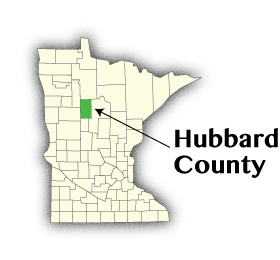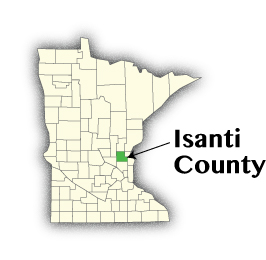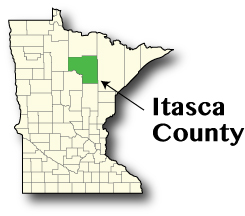by Tim O'Neill
November 2017

If you drive along State Highways 371 or 200 or along U.S. Highways 71 or 2, you are bound to make an appearance in Hubbard County. Positioned in the very center of northern Minnesota, Hubbard County is home to 20,640 people, five cities, and 28 townships. The largest of the cities, and also the county seat, is Park Rapids. Top destinations in Hubbard County include Itasca State Park, Mississippi Headwaters State Park, Badoura State Forest Nursery, Paul Bunyan State Forest, tiny Dorset, and Kabekona Lake. A portion of the Leech Lake Indian Reservation is also within the county. Hubbard County was organized in 1887 and named after Lucius Frederick Hubbard, who was governor of Minnesota between 1882 and 1887.
As of annual 2016 Hubbard County had 580 establishments supplying 5,981 covered jobs. Analyzing industry supersectors, Education and Health Services, with over 1,300 jobs, accounts for over one in five county jobs. Trade, Transportation, and Utilities, just shy of 1,300 jobs, also accounts for over one in five county jobs. Combined with Manufacturing, nearly 60 percent of Hubbard County's total employment is in three top employing supersectors.
Hubbard County's total employment has witnessed its fair share of fluctuation. After peaking at over 6,500 jobs in 2004, the county's total employment contracted by 14.3 percent through 2011, losing 929 jobs. Between 2011 and 2016 the county regained just over 400 jobs, expanding by 7.2 percent. Between 2015 and 2016 the county expanded by 2.7 percent, faster than the state's 1.4 percent growth during that time.
As of second quarter 2017 Hubbard County's total employment had increased further to 6,314 jobs. Zooming in on the major industry sectors, the largest-employing industries included Retail Trade (1,015 jobs), Health Care and Social Assistance (883 jobs), Manufacturing (878 jobs), Accommodation and Food Services (766 jobs), and Public Administration (552 jobs). Of 20 major industry sectors, these five accounted for nearly two-thirds of the county's total employment.
Manufacturing, like the total employment, has witnessed major shifts in Hubbard County. Between the second quarters of 2002 and 2012 this sector lost 721 jobs, declining by 51.8%. Between 2012 and 2017 Manufacturing regained 206 jobs, expanding by 30.7 percent.
| Estimates | Hubbard County | Minnesota |
|---|---|---|
| Population | 20,640 | 5,519,952 |
| Labor Force | 9,748 | 3,066,990 |
| Average Unemployment | 5.5% (533 people) | 2.6% (80,545 people) |
| Median Annual Earnings | $26,391 | $34,819 |
| Cost of Living, Individual | $25,592 ($12.30 per hour) | $29,856 ($14.35 per hour) |
| Cost of Living, Average Family | $44,698 ($14.33 per hour) | $55,200 ($17.69 per hour) |
| Source: DEED Local Area Unemployment Statistics November 2017; DEED Cost of Living in Minnesota 2017; U.S. Census Bureau, 2016 American Community Survey Estimates | ||
| Top Industries of Employment | 2016 Annual Data | 2010 – 2016 Percent Change | |||
|---|---|---|---|---|---|
| Number of Firms | Number of Jobs | Average Wage | Employment | Average Wage | |
| Total, All Industries | 580 | 5,981 | 35,204 | 5.4% | 18.8% |
| Education and Health Services | 51 | 1,305 | 47,528 | -5.9% | 26.8% |
| Trade, Transportation, and Utilities | 130 | 1,265 | 27,768 | 8.8% | 20.8% |
| Manufacturing | 29 | 854 | 45,448 | 27.1% | 16.7% |
| Leisure and Hospitality | 93 | 779 | 12,792 | 3.5% | 12.8% |
| Source: DEED Quarterly Census of Employment and Wages (QCEW) | |||||

Drive along State highways 65 or 95 and your commute is likely to bring you through Isanti County. Fully a part of the Minneapolis-St. Paul Metropolitan Statistical Area (MSA), Isanti County is only about an hour's drive away from either of the Twin Cities. Isanti County has three cities, 13 townships, and one ghost town. Altogether these cities and townships are home to just over 38,400 people.
Originally founded in February, 1857, Isanti County's population swelled to 11,675 by the turn of the 19th century. Over the next 50 years, between 1900 and 1950, the county's population stagnated, growing only by 3.8 percent. Over the last half of the 20th century, however, the county's total population boomed again. Between 1950 and 2000 the county grew by 158 percent, adding more than 19,100 people to its population. Since 2000 the county has continued to grow, adding more than 7,100 people through 2016. Over 3,100 of those people have settled in Cambridge, the county seat.
The Great Recession hit Isanti County hard between 2007 and 2010. After peaking at 10,980 jobs in 2007, the county contracted by 7.6 percent, losing 832 jobs through 2010. Since 2010, however, the county has regained 718 jobs, growing by 7.1 percent. The county may be close to surpassing its 2007 level of employment, but stumbled in that effort recently, losing 116 jobs between 2015 and 2016.
As of second quarter 2017 Isanti County had 778 establishments supplying 10,973 covered jobs. Of these jobs, more than one in five were in Health Care and Social Assistance (2,440 jobs). Other large-employing sectors included Retail Trade (1,714 jobs), Manufacturing (1,432 jobs), and Educational Services (1,296 jobs). Of 20 major industry sectors, Health Care and Social Assistance, Retail Trade, Manufacturing, and Educational Services accounted for 63 percent of the county's total employment.
Over the past five years, between the second quarters of 2012 and 2017, Construction was both Isanti County's largest- and fastest-growing industry. More specifically, Construction employment grew by 89.9 percent, adding 240 jobs. For reference, total county employment grew by 4.7 percent during that time, adding 492 jobs. Other large-growing industries included Retail Trade (156 jobs), Public Administration (83 jobs), Information (52 jobs), and Real Estate, Rental, and Leasing (35 jobs).
| Estimates | Isanti County | Minnesota |
|---|---|---|
| Population | 38,461 | 5,519,952 |
| Labor Force | 20,880 | 3,066,990 |
| Average Unemployment | 3.5% (727 people) | 2.6% (80,545 people) |
| Median Annual Earnings | $32,759 | $34,819 |
| Cost of Living, Individual | $34,407 ($16.54 per hour) | $29,856 ($14.35 per hour) |
| Cost of Living, Average Family | $62,979 ($20.19 per hour) | $55,200 ($17.69 per hour) |
| Source: DEED Local Area Unemployment Statistics November 2017; DEED Cost of Living in Minnesota 2017; U.S. Census Bureau, 2016 American Community Survey Estimates | ||
| Top Industries of Employment | 2016 Annual Data | 2010 – 2016 Percent Change | |||
|---|---|---|---|---|---|
| Number of Firms | Number of Jobs | Average Wage | Employment | Average Wage | |
| Total, All Industries | 749 | 10,866 | $38,480 | 7.1% | 13.3% |
| Education and Health Services | 83 | 3,785 | $41,340 | 0.6% | 12.8% |
| Trade, Transportation, and Utilities | 156 | 2,264 | $31,148 | 5.5% | 3.3% |
| Manufacturing | 68 | 1,477 | $51,324 | 31.4% | 12.7% |
| Leisure and Hospitality | 58 | 896 | $13,156 | 10.9% | 23.4% |
| Source: DEED Quarterly Census of Employment and Wages (QCEW) | |||||

Established in 1849, Itasca County was one of the first counties to form in Minnesota. Being a county might have been a surprise to some at first, as its population growth remained largely flat through 1900. Between 1900 and 1940, however, the county's population spiked by 622 percent adding more than 28,000 people. Growth seesawed some through the end of the century, but the county managed to add another 11,000 people between 1940 and 2000. Between 2000 and 2016, growth cooled off considerably, with the population total increasing by only 1,364 people. This cooling off may be, in part, from the county's aging population. As of 2016 the median age in Itasca County was 45.9 years, significantly higher than the state's median age of 37.8 years. Further, between 2010 and 2016 Itasca County had more deaths than births, but made up for some of this change with domestic and international migration.
There's plenty of room for all in Itasca County. With an area of 2,665 square miles, Itasca County is Minnesota's third largest county, behind only Saint Louis and Koochiching counties. With such a large area spanning the north central region of the state, Itasca County is home to a rich variety of landscapes and over 1,400 lakes. The county is also home to 21 cities, 42 townships, and five unorganized territories. Grand Rapids, with a population of 11,211, is the county seat.
As of annual 2016 1,161 establishments supplied 15,748 jobs in Itasca County. Broken down by major industry sectors, the largest-employing sectors in the county are Health Care and Social Assistance, Retail Trade, Educational Services, Accommodation and Food Services, and Public Administration. Altogether, these five industries account for 65 percent of the county's total employment.
In the last five years of available data, between the second quarters of 2012 and 2017, total employment in Itasca County slipped by a slight 1.7 percent. Bolstering the county during that time was Health Care and Social Assistance, which grew by 19.6 percent, equivalent to over 600 jobs. Other growing industries included Educational Services, Accommodation and Food Services, and Retail Trade. On the other end of the spectrum, Construction employment in Itasca County fell by 37.1 percent, equivalent to 420 jobs lost. Other industries experiencing weakness in the county included Manufacturing, Administrative and Support Services, Public Administration, and Professional, Scientific, and Technical Services.
| Estimates | Itasca County | Minnesota |
|---|---|---|
| Population | 45,356 | 5,519,952 |
| Labor Force | 21,306 | 3,066,990 |
| Average Unemployment | 6.1% (1,292 people) | 2.6% (80,545 people) |
| Median Annual Earnings | $27,072 | $34,819 |
| Cost of Living, Individual | $26,898 ($12.93 per hour) | $29,856 ($14.35 per hour) |
| Cost of Living, Average Family | $47,072 ($15.09 per hour) | $55,200 ($17.69 per hour) |
| Source: DEED Local Area Unemployment Statistics November 2017; DEED Cost of Living in Minnesota 2017; U.S. Census Bureau, 2016 American Community Survey Estimates | ||

It's time to head to Minnesota's Deep South in Jackson County. Founded in 1857, Jackson County, named for Henry Jackson, the first merchant in Saint Paul, witnessed a flurry of newcomers between 1860 and 1900. During this span of 40 years, the county added more than 14,600 people, increasing by more than 8000 percent. Growth continued at a much more sustainable pace through 1940, when the county population peaked at 16,805 people. Since 1940, however, Jackson County's population has steadily declined. More specifically, the county population contracted by 39.5 percent through 2016, where it now sits at an estimated 10,163 people.
Like Hubbard and Itasca counties, Jackson County has an older population. As of 2016 the median age in the county was 43.4 years, quite a bit higher than the state's 37.8 years. Also like this issue's tour of Hubbard, Isanti, and Itasca counties, Jackson County has a predominantly White, not Hispanic or Latino population. Where 81.3 percent of Minnesotans self-report as white, not Hispanic or Latino, 93.3 percent do so in Jackson County.1
Jackson County is home to seven cities and 18 townships. With a population of 3,238 people, Jackson is the largest city in the county and is also the county seat.
As of annual 2016, Jackson County had 337 establishments supplying 5,427 jobs. Over half of these jobs, 55.5 percent, were in Educational and Health Services and Manufacturing. Throughout the 2000s and early 2010s, total Jackson County employment grew at a slow, but steady pace. Between 2000 and 2014 the county added 1,375 jobs, growing by an annual average of 2.2 percent. Between 2014 and 2016 total employment slipped by 5.7 percent, losing 330 jobs.
Mention should also be made of Jackson County's agriculture. According to the U.S. Census of Agriculture, the county had 826 farms in 2012, with an average farm size of 433 acres. With the market value of total products sold north of $376.3 million in 2012, the county is especially known for hogs and pigs.
| Top Industries of Employment | 2016 Annual Data | 2010 – 2016 Percent Change | |||
|---|---|---|---|---|---|
| Number of Firms | Number of Jobs | Average Wage | Employment | Average Wage | |
| Total, All Industries | 1,161 | 15,748 | $39,728 | 1.2% | 15.8% |
| Education and Health Services | 187 | 4,979 | $37,596 | 11.7% | 8.7% |
| Trade, Transportation, and Utilities | 268 | 3,367 | $39,780 | 1.3% | 18.4% |
| Leisure and Hospitality | 125 | 1,744 | $16,068 | 4.5% | 19.8% |
| Public Administration | 60 | 1,327 | $46,280 | -9.2% | 17.4% |
| Source: DEED Quarterly Census of Employment and Wages (QCEW) | |||||
| Estimates | Jackson County | Minnesota |
|---|---|---|
| Population | 10,163 | 5,519,952 |
| Labor Force | 6,007 | 3,066,990 |
| Average Unemployment | 2.3% (137 people) | 2.6% (80,545 people) |
| Median Annual Earnings | $31,113 | $34,819 |
| Cost of Living, Individual | $25,037 ($12.04 per hour) | $29,856 ($14.35 per hour) |
| Cost of Living, Average Family | $42,957 ($13.77 per hour) | $55,200 ($17.69 per hour) |
| Source: DEED Local Area Unemployment Statistics November 2017; DEED Cost of Living in Minnesota 2017; U.S. Census Bureau, 2016 American Community Survey Estimates | ||
| Top Industries of Employment | 2016 Annual Data | 2010 – 2016 Percent Change | |||
|---|---|---|---|---|---|
| Number of Firms | Number of Jobs | Average Wage | Employment | Average Wage | |
| Total, All Industries | 337 | 5,427 | $35,672 | 5.6% | 19.5% |
| Educational and Health Services | 34 | 1,615 | $24,284 | 3.7% | 12.0% |
| Manufacturing | 13 | 1,396 | $53,040 | 8.0% | 22.3% |
| Trade, Transportation, and Utilities | 86 | 939 | $38,636 | 19.6% | 18.5% |
| Leisure and Hospitality | 33 | 347 | $10,036 | 6.8% | 28.7% |
| Source: DEED Quarterly Census of Employment and Wages (QCEW) | |||||
193.3 percent self-report as white, not Hispanic or Latino in Hubbard County, 94.4 percent in Isanti County, and 92.2 percent in Itasca County. This information comes from the 2012-2016 American Community Survey (ACS) 5-year estimates.